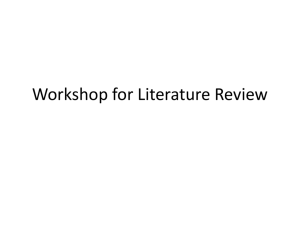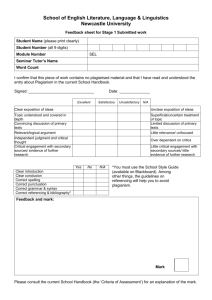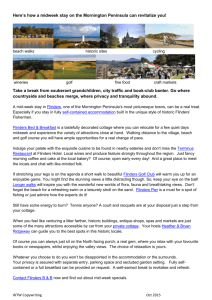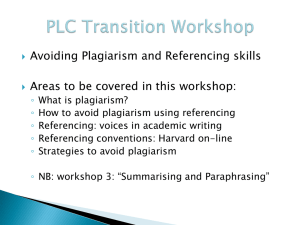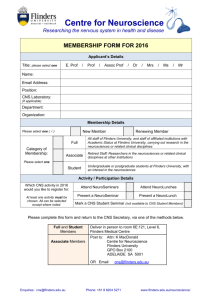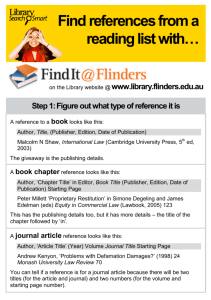Business Report Writing Workshop
advertisement
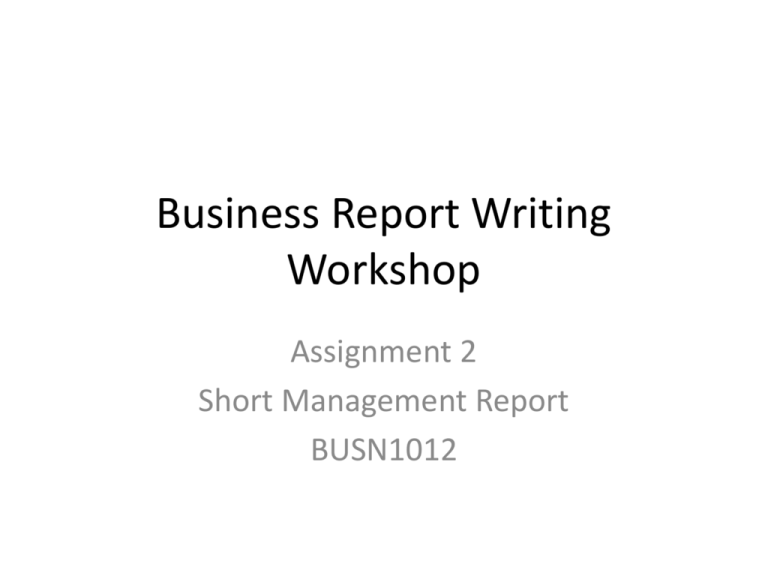
Business Report Writing Workshop Assignment 2 Short Management Report BUSN1012 Format of a business report • A business report normally consists of the following sections: – – – – – – – – Title page Executive summary Table of contents Introduction Main body Conclusion Reference list and Appendices (where relevant) The good…… • This report is an excellent example of the style and content that we are looking for. • Note that this assignment has the following sections: – – – – – Title page Table of contents Main body – split into meaningful sections Conclusion Reference list This report used nine references from a variety of sources – journals, press, internet and books. The bad…… • This report follows some of the template that we would expect of a business style report – such as a title page, a table of contents and a conclusion…. • HOWEVER there are sections that would not normally be included such as scope (which would more likely be found in a project document) and the methodology section (which would be more appropriate in a research paper). • Note that this report only had four references and one of these was the text for the unit. Peer reviewed journal articles are viewed more favourably. The very very ugly….. • This report failed to follow the template that is expected for a business report. There was no table of contents and the contents were not split into sections. • Whilst there was a reference list, both the end text and in-text referencing has been done incorrectly. For example the first reference on the list is actually an article from the New York times. It should have been listed as follows: Fackler, M and Belson, K. (2006). ‘PlayStation 3 Pushed Back For Delivery In November’. New York Times, Late Edition (East Coast) [New York, N.Y] 16 Mar 2006: C.1. http://search.proquest.com.ezproxy.flinders.edu.au/docvi ew/433308664?accountid=10910 The very very ugly continued …. • There was not a wide range of references used. • The in text referencing was also done incorrectly. Generic Report Structure SECTION FUNCTION WRITING STRATEGIES Title page / cover page Indicate topic/main finding to reader Concise formulation of topic Executive summary /abstract 1. 2. Summarise, present main data, conclude, recommend Table of contents, list of figures/tables Make information easy to find Categorise, order Introduction 1. 2. 3. Describes, arouses interest, constraints, proposal, claim The message of your report Outline of your: • methods, • findings, • conclusions, • implications, • recommendations. Aim, scope and limitations Set context Outline of report structure Background/literature survey (optional – may be included Gives relevant context of problem and previous findings in the introduction) Describe, define, summarise, explain Body 1. 2. 3. 4. Provides justification for recommendation(s) Presents methods and findings Is based on evidence Keeps the discussion concise Describe, report, refer to tables and figures, analyse, interpret, synthesise, argue, infer, evaluate, predict, conclude Conclusion 1. 2. Restates position/key message Presents and evaluates possible solutions Conclude Recommendations (optional) Suggests appropriate policy/actions References (or Bibliography) Provides justification for information, enables follow up and Accuracy, consistency, academic integrity further study, acknowledges intellectual property of others Appendices (optional) Contains detailed or bulky information on background, methods, or data Source: https://academicskills.anu.edu.au/node/89 Recommends Clarity Use of appropriate references When you write an assignment, you create an argument for your point of view, giving evidence for that view. The evidence that you give will come from the sources you have read. Hence, the quality of your argument will partly depend on the quality of your sources. • If you use a source that is not accurate or well-informed, you do not look like a good student. Your lecturers may suspect that you used the first sources you found and will assume that you do not have a good understanding of ideas related to your topic. • Choosing good sources means paying attention to who wrote the information, why and how they wrote it. • • Can I reference Wikipedia? Wikipedia is useful for finding simple definitions and may be useful for directing you to relevant references and sources. However, as Wikipedia can be updated by anyone, there is some question about its credibility. What kind of sources should I reference? • You should predominantly reference published materials (e.g. books, journal articles (including electronic journals), newspapers, reports). • You can reference electronic sources, but you should ensure they are reputable and provide information about who wrote them and when they were published on the web. Web pages with no date or author are not reputable. Where to find references As students of Flinders University, you have free access to a number of databases for journals, articles, conference papers, newspaper articles, textbooks, reference books etc. You can access databases online at: - Go to www.Flinders.edu.au (or http://multisearch.flinders.edu.au:8331/V/?func=find-db-1) - Click on the Library tab. - Click on Databases - Choose your database you want to search from. For example, ProQuest, Business Periodicals Index Retrospective, AEM (Informit), ABS, Econlit, Factiva, Wiley Interscience - You can then start your search once you are in the database. Finding journal articles in the library http://www.flinders.edu.au/library/ Harvard Referencing Why are there referencing systems? – Referencing is a standardised way of informing readers of the sources of information, ideas, graphics etc. that are used in any given work. – It also acknowledges other people’s work and ideas. – It is integral to academic integrity and writing. – Accurate referencing enables readers to locate your sources if they are interested in following up on the topic. There are two parts to the Harvard Referencing system: 1. In-text Referencing 2. The reference list Refer to handout on Harvard Referencing System http://www.flinders.edu.au/slc_files/Documents/Blue%20Guides/Harvard%20Referencing.pdf What is plagiarism? • Plagiarism is when you use someone else's ideas, thoughts or material and do not acknowledge that these belong to someone else. For example – if you copy a section of a book and put it in your essay without changing any of it and you don’t reference it, this is plagiarism. It is important that you acknowledge all the sources from where you have got your information…… How can I check that I have not plagiarised? Using TURNITIN • TURNITIN is a computer program that enables you to electronically upload your assignment and check whether or not any of your assignment match …. A) other peoples’ essays from your class (collusion) B) whether or not there are any areas of your essay that constitute plagiarism. Academic writing style Formal academic writing is quite different from informal spoken English. The differences can best be seen from a number of examples: CONTRACTIONS HESITATION FILLERS PERSONAL PRONOUNS Informal / Imprecise Words Abbreviated Forms INCORRECT CORRECT it didn’t they’ve it’s they’re it did not they have it is they are er, um, well… I think this is an effective plan. You put the chemicals in the test tube. We used two different methods of research. This could be an effective plan. The chemicals are put in the test tube. There were two different methods of research. lots of, nice, big, things, like many, excellent, pleasant, large, reasons, problems, such as e.g, i.e, etc For example, that is, and so on Source: http://www.flinders.edu.au/slc_files/Documents/Yellow%20Guides/Formal%20&%20Informal%20Language.pdf What is Paraphrasing? • Paraphrasing is using someone else's ideas but expressing them in your own words. • Paraphrasing is ok to do as long as you still reference the original source. • Quoting is when you use someone else’s idea and you included it word for word. Quoting involves the use of the quotation marks to enable the reader to identify quoted work. This also needs to be referenced using the accepted referencing method (Harvard). Useful on-line resource for Academic Writing http://www.flinders.edu.au/currentstudents/slc/study-resources/studyresources.cfm Contact details • If you would like any further information or have any questions from today please contact • Heather Dawson-Howard (heather.dawsonhoward@flinders.com.au) • Oliver Yeo (oliver.yeo@flinders.com.au)


